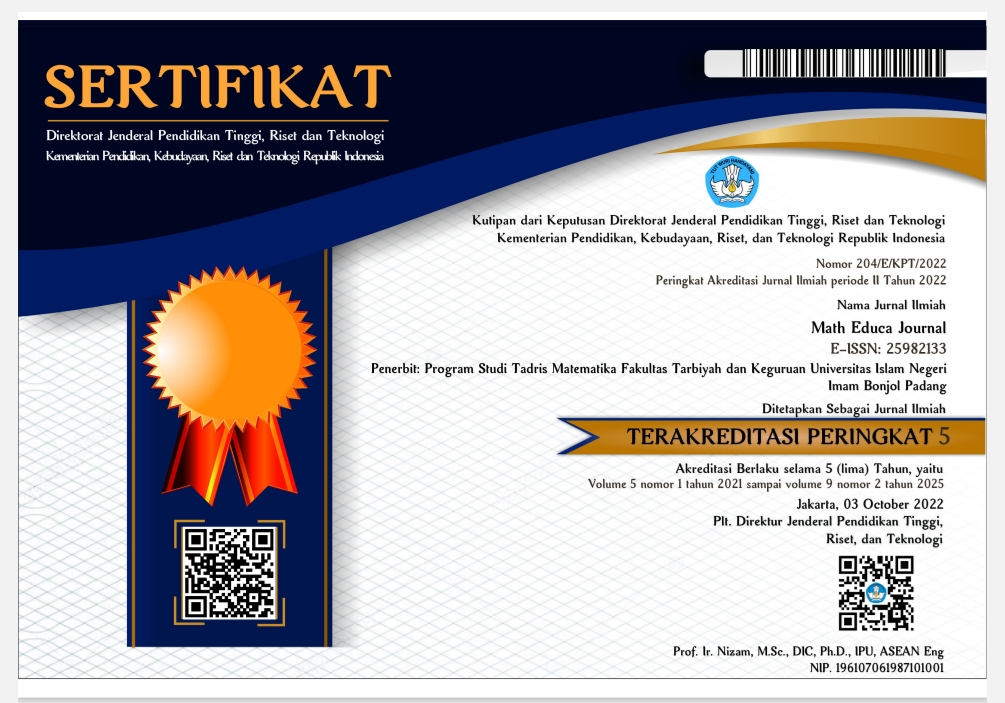ANALISIS KEMAMPUAN CALON GURU MATEMATIKA DALAM MEMBUAT SOAL PEMECAHAN MASALAH MATEMATIKA
Abstract
Keywords
Full Text:
PDFReferences
Bell, F. (1978). Teaching and Learning Mathematics: In Secondary Schools (Second Pri). Wm. C. Brown. Company.
Chapman, O. (2015). Mathematics Teachers’ Knowladge for Teaching Problem Solving. Lumat, 3(1), 19–36.
Demirel, M., Derman, I., & Karagedik, E. (2015). A study on the relationship between reflective thinking skills towards problem solving and attitudes towards mathematics. Procedia - Social and Behavioral Sciences, 197(February), 2086–2096. https://doi.org/10.1016/j.sbspro.2015.07.326
Fauzan, A. (2010). Modul PPG Assesmen Berbasis Kelas Dalam Pembelajaran Matematika. FMIPA UNP.
Kemendikbud RI. (2020). Laporan Hasil Ujian Nasional 2019. Kemendikbud RI.
Kurniasih, A. W. (2016). Budaya Mengembangkan Soal Cerita Kontekstual Open-Ended Mahasiswa Calon Guru Matematika untuk Meningkatkan Berpikir Kritis. Prosiding Seminar Nasional MatematikaSeminar Nasional Matematika, 5, 9–17.
Lestari, H., Fitriza, R., & A, H. (2020). Pengaruh Kecemasan Matematika (Mathematics Anxiety) terhadap Kemampuan Pemecahan Masalah Peserta Didik Kelas VII Mts. Math Educa, 4(1).
Lestari, L., & Sofyan, D. (2014). Perbandingan Kemampuan Pemecahan Masalah Siswa dalam Matematika Antara Yang Mendapat Pembelajaran Matematika Realistik (PMR) dengan Pembelajaran Konvensional. Mosharafa, 3, 95–108.
Lutfianto, M., Zulkardi, & Hartono, Y. (2012). Unfinished Student Answer In Pisa Mathematics Contextual Problem. Journal on Mathematics Education, 4(2).
Mullis, I. V. S., Martin, M. O., Foy, P., & Hooper, M. (2015). TIMSS 2015 International Results in Mathematics.
NCTM. (2000). Principles and Standards for School Mathematics.
Permendikbud. (2014). Peraturan Menteri Pendidikan dan Kebudayaan Republik Indonesia Nomor 103 Tahun 2014 Tentang Pembelajaran pada Pendidikan Dasar dan Menengah.
Polya, G. (1973). How to Solve It. Princeton University Press.
Reiss, K., & Törner, G. (2007). Problem solving in the mathematics classroom: The German perspective. ZDM - International Journal on Mathematics Education, 39(5–6), 431–441. https://doi.org/10.1007/s11858-007-0040-5
Samo, D. D. (2017). Kemampuan Pemecahan Masalah Mahasiswa Tahun Pertama pada Masalah Geometri Konteks Budaya. Jurnal Riset Pendidikan Matematika, 4(2), 141–152.
Schleicher, A. (2018). PISA 2018 Insights and Interpretations.
Schoenfeld, A. H. (1987). Polya, Problem Solving, and Education. Mathematic Magazine, 60(5), 283–291.
https://doi.org/10.2307/2972154
Siswono, T. Y. E. (2018). Pembelajaran Matematika. Rosda Karya.
Suherman dkk, E. (2002). Startegi Pembelajaran Matematika Komtemporer. UPI.
Wardani, S., Setiawan, B., & Hastuti, S. (n.d.). Analisis Kesalahan Berbahasa pada Soal Ujian Pelajaran Bahasa Indonesia. Basastra, 8(April 2020), 180–194.
Youngchim, P., Pasiphol, S., & Sujiva, S. (2015). Development of a Mathematical Problem Solving Diagnostic Method: An Application of Bayesian Networks and Multidimensional item Respond Theory. Procedia - Social and Behavioral Sciences, 191, 742–747. https://doi.org/https://doi.org/10.1016/j.sbspro.2015.04.497
Refbacks
- There are currently no refbacks.

This work is licensed under a Creative Commons Attribution-NonCommercial-ShareAlike 4.0 International License.
The Journal Space of the Mathematics Education Department
Faculty of Education and Teacher Training
State Islamic University of Imam Bonjol Padang
Email: mej.uinibpadang@gmail.com

Math Educa Journal is licensed under a Lisensi Creative Commons Atribusi-NonKomersial 4.0 Internasional.
Based on a work at https://ejournal.uinib.ac.id/jurnal/index.php/matheduca.
All rights reserved p-ISSN: 2580-6726 | e-ISSN: 2598-2133




